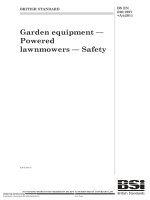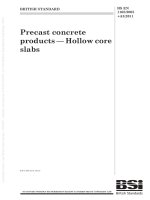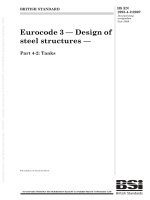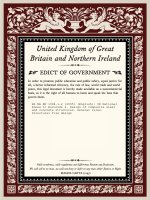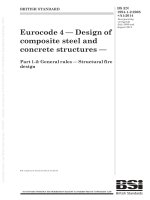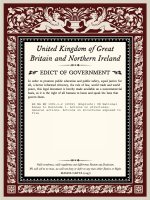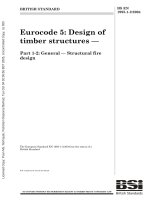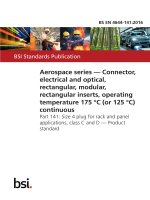Bsi bs en 61753 141 2 2011
Bạn đang xem bản rút gọn của tài liệu. Xem và tải ngay bản đầy đủ của tài liệu tại đây (1.09 MB, 20 trang )
BS EN 61753-141-2:2011
BSI Standards Publication
Fibre optic interconnecting
devices and passive
components —
Performance standard
Part 141-2: Fibre optic passive chromatic
dispersion compensator using single-mode
dispersion compensating fibre for category C
— Controlled environments
BRITISH STANDARD
BS EN 61753-141-2:2011
National foreword
This British Standard is the UK implementation of EN 61753-141-2:2011.
It is identical to IEC 61753-141-2:2011.
The UK participation in its preparation was entrusted by Technical Committee
GEL/86, Fibre optics, to Subcommittee GEL/86/2, Fibre optic interconnecting
devices and passive components.
A list of organizations represented on this committee can be obtained on
request to its secretary.
This publication does not purport to include all the necessary provisions of a
contract. Users are responsible for its correct application.
© BSI 2011
ISBN 978 0 580 63062 0
ICS 33.180.20
Compliance with a British Standard cannot confer immunity
from legal obligations.
This British Standard was published under the authority of the
Standards Policy and Strategy Committee on 31 July 2011.
Amendments issued since publication
Amd. No.
Date
Text affected
BS EN 61753-141-2:2011
EUROPEAN STANDARD
EN 61753-141-2
NORME EUROPÉENNE
May 2011
EUROPÄISCHE NORM
ICS 33.180.20
English version
Fibre optic interconnecting devices and passive components Performance standard Part 141-2: Fibre optic passive chromatic dispersion compensator using
single-mode dispersion compensating fibre for category C Controlled environments
(IEC 61753-141-2:2011)
Dispositifs d'interconnexion et composants
passifs à fibres optiques Norme de performance Partie 141-2: Compensateur de dispersion
chromatique passif à fibres optiques
utilisant une fibre à compensation de
dispersion unimodale pour la catégorie C Environnements contrôlés
(CEI 61753-141-2:2011)
Lichtwellenleiter Verbindungselemente und passive
Bauteile Betriebsverhalten Teil 141-2: Passiver chromatischer
Dispersionskompensator mit
dispersionskompensierender
Einmodenfaser für die Kategorie C Kontrollierte Umgebung
(IEC 61753-141-2:2011)
This European Standard was approved by CENELEC on 2011-05-25. CENELEC members are bound to comply
with the CEN/CENELEC Internal Regulations which stipulate the conditions for giving this European Standard
the status of a national standard without any alteration.
Up-to-date lists and bibliographical references concerning such national standards may be obtained on
application to the Central Secretariat or to any CENELEC member.
This European Standard exists in three official versions (English, French, German). A version in any other
language made by translation under the responsibility of a CENELEC member into its own language and notified
to the Central Secretariat has the same status as the official versions.
CENELEC members are the national electrotechnical committees of Austria, Belgium, Bulgaria, Croatia, Cyprus,
the Czech Republic, Denmark, Estonia, Finland, France, Germany, Greece, Hungary, Iceland, Ireland, Italy,
Latvia, Lithuania, Luxembourg, Malta, the Netherlands, Norway, Poland, Portugal, Romania, Slovakia, Slovenia,
Spain, Sweden, Switzerland and the United Kingdom.
CENELEC
European Committee for Electrotechnical Standardization
Comité Européen de Normalisation Electrotechnique
Europäisches Komitee für Elektrotechnische Normung
Management Centre: Avenue Marnix 17, B - 1000 Brussels
© 2011 CENELEC - All rights of exploitation in any form and by any means reserved worldwide for CENELEC members.
Ref. No. EN 61753-141-2:2011 E
BS EN 61753-141-2:2011
EN 61753-141-2:2011
Foreword
The text of document 86B/3162/FDIS, future edition 1 of IEC 61753-141-2, prepared by SC 86B, Fibre
optic interconnecting devices and passive components, of IEC TC 86, Fibre optics, was submitted to the
IEC-CENELEC parallel vote and was approved by CENELEC as EN 61753-141-2 on 2011-05-25.
Attention is drawn to the possibility that some of the elements of this document may be the subject of
patent rights. CEN and CENELEC shall not be held responsible for identifying any or all such patent
rights.
The following dates were fixed:
– latest date by which the EN has to be implemented
at national level by publication of an identical
national standard or by endorsement
(dop)
2012-02-25
– latest date by which the national standards conflicting
with the EN have to be withdrawn
(dow)
2014-05-25
Annex ZA has been added by CENELEC.
__________
Endorsement notice
The text of the International Standard IEC 61753-141-2:2011 was approved by CENELEC as a European
Standard without any modification.
In the official version, for Bibliography, the following note has to be added for the standard indicated:
In the official version, for Bibliography, the following notes have to be added for the standards indicated:
IEC 61753-1
NOTE Harmonized as EN 61753-1.
IEC 62074-1
NOTE Harmonized as EN 62074-1.
__________
BS EN 61753-141-2:2011
EN 61753-141-2:2011
Annex ZA
(normative)
Normative references to international publications
with their corresponding European publications
The following referenced documents are indispensable for the application of this document. For dated
references, only the edition cited applies. For undated references, the latest edition of the referenced
document (including any amendments) applies.
NOTE When an international publication has been modified by common modifications, indicated by (mod), the relevant EN/HD
applies.
Publication
Year
Title
EN/HD
Year
IEC 60793-2-50
-
Optical fibres Part 2-50: Product specifications - Sectional
specification for class B single-mode fibres
EN 60793-2-50
-
IEC 61300-2-1
-
Fibre optic interconnecting devices and
passive components - Basic test and
measurement procedures Part 2-1: Tests - Vibration (sinusoidal)
EN 61300-2-1
-
IEC 61300-2-4
-
Fibre optic interconnecting devices and
passive components - Basic test and
measurement procedures Part 2-4: Tests - Fibre/cable retention
EN 61300-2-4
-
IEC 61300-2-9
-
Fibre optic interconnecting devices and
passive components - Basic test and
measurement procedures Part 2-9: Tests - Shock
EN 61300-2-9
+ AC:2011
-
IEC 61300-2-17
-
Fibre optic interconnecting devices and
passive components - Basic test and
measurement procedures Part 2-17: Tests - Cold
EN 61300-2-17
-
IEC 61300-2-18
-
EN 61300-2-18
Fibre optic interconnecting devices and
passive components - Basic test and
measurement procedures Part 2-18: Tests - Dry heat - High temperature
endurance
-
IEC 61300-2-19
-
Fibre optic interconnecting devices and
passive components - Basic test and
measurement procedures Part 2-19: Tests - Damp heat (steady state)
EN 61300-2-19
-
IEC 61300-2-22
-
Fibre optic interconnecting devices and
passive components - Basic test and
measurement procedures Part 2-22: Tests - Change of temperature
EN 61300-2-22
-
IEC 61300-2-42
-
Fibre optic interconnecting devices and
passive components - Basic test and
measurement procedures Part 2-42: Tests - Static side load for
connectors
EN 61300-2-42
-
IEC 61300-2-44
-
EN 61300-2-44
Fibre optic interconnecting devices and
passive components - Basic test and
measurement procedures Part 2-44: Tests - Flexing of the strain relief of
fibre optic devices
-
BS EN 61753-141-2:2011
EN 61753-141-2:2011
Publication
Year
Title
EN/HD
Year
IEC 61300-3-2
-
EN 61300-3-2
Fibre optic interconnecting devices and
passive components - Basic test and
measurement procedures Part 3-2: Examinations and measurements Polarization dependent loss in a single-mode
fibre optic device
-
IEC 61300-3-4
-
Fibre optic interconnecting devices and
passive components - Basic test and
measurement procedures Part 3-4: Examinations and measurements Attenuation
EN 61300-3-4
-
IEC 61300-3-7
-
Fibre optic interconnecting devices and
passive components - Basic test and
measurement procedures Part 3-7: Examinations and measurements Wavelength dependence of attenuation and
return loss of single mode components
FprEN 61300-3-7
IEC 61300-3-32
-
EN 61300-3-32
Fibre optic interconnecting devices and
passive components - Basic test and
measurement procedures Part 3-32: Examinations and measurements Polarisation mode dispersion measurement
for passive optical components
1)
-
-
-
-
IEC/PAS 61300-3-38 -
Fibre optic interconnecting devices and
passive components - Basic test and
measurement procedures Part 3-38: Group delay and chromatic
dispersion
IEC 61753-021-2
-
EN 61753-021-2
Fibre optic interconnecting devices and
passive components performance standard Part 021-2: Grade C/3 single-mode fibre optic
connectors for category C - Controlled
environment
IEC 61978-1
-
Fibre optic interconnecting devices and
passive components - Fibre optic passive
chromatic dispersion compensators Part 1: Generic specification
EN 61978-1
-
ITU-T
Recommendation
G.Sup39
-
Optical system design and engineering
considerations
-
-
1)
At draft stage.
-
BS EN 61753-141-2:2011
61753-141-2 IEC:2011
CONTENTS
1
Scope . ............................................................................................................................................. 5
2
Normative references . .................................................................................................................. 5
3
Terms and definitions . .................................................................................................................. 6
4
Test .................................................................................................................................................. 7
5
Test report. ..................................................................................................................................... 7
6
Performance requirements . ......................................................................................................... 7
6.1
6.2
6.3
Annex A
Reference components . ...................................................................................................... 7
Dimensions . ......................................................................................................................... 7
Test details and requirements . ......................................................................................... 7
(normative) Sample size . ................................................................................................. 14
Bibliography ......................................................................................................................................... 15
Table 1 – Test and requirements for single channel application . .................................................. 8
Table 2 – Test and requirements for C-band WDM application . .................................................... 9
Table 3 – Test and requirements for L-band WDM application . .................................................. 10
Table 4 – Test and requirements for all applications . ................................................................... 11
Table A.1 – Sample size for the tests in Table 1 ........................................................................... 14
Table A.2 – Sample size for the tests in Table 2 ........................................................................... 14
BS EN 61753-141-2:2011
61753-141-2 IEC:2011
–5–
FIBRE OPTIC INTERCONNECTING DEVICES
AND PASSIVE COMPONENTS –
PERFORMANCE STANDARD –
Part 141-2: Fibre optic passive chromatic dispersion compensator using
single-mode dispersion compensating fibre for category C –
Controlled environments
1
Scope
This part of IEC 61753 contains the minimum test and measurement requirements and
severity levels that a fibre optic passive chromatic dispersion compensator (PCDC) using
single-mode dispersion compensating fibre (DCF) must satisfy in order to be categorised as
meeting the IEC standard, Category C – Controlled Environments. Generally, PCDCs are
used to reduce the magnitude of chromatic dispersion (CD) between regenerators by adding
CD to the span that has a sign opposite to the total CD of the cabled fibre and components.
The requirements cover non-connectorised PCDCs with single-mode fibre at both ends used
in single-channel transmission and wavelength division multiplexing (WDM) transmission in
single mode fibres (SMF) (IEC60793-2-50, B1/B2/B4).
2
Normative references
The following referenced documents are indispensable for the application of this document.
For dated references, only the edition cited applies. For undated references, the latest edition
of the referenced document (including any amendments) applies.
IEC 60793-2-50: Optical fibres – Part 2-50: Product specifications – Sectional specification for
class B single-mode fibres
IEC 61300-2-1, Fibre optic interconnecting devices and passive components – Basic test and
measurement procedures – Part 2-1: Tests – Vibration (sinusoidal)
IEC 61300-2-4, Fibre optic interconnecting devices and passive components – Basic test and
measurement procedures – Part 2-4: Tests – Fibre/cable retention
IEC 61300-2-9, Fibre optic interconnecting devices and passive components – Basic test and
measurement procedures – Part 2-9: Tests – Shock
IEC 61300-2-17, Fibre optic interconnecting devices and passive components – Basic test and
measurement procedures – Part 2-17: Tests – Cold
IEC 61300-2-18, Fibre optic interconnecting devices and passive components – Basic test and
measurement procedures – Part 2-18: Tests – Dry heat – High temperature endurance
IEC 61300-2-19, Fibre optic interconnecting devices and passive components – Basic test and
measurement procedures – Part 2-19: Tests – Damp heat (steady state)
IEC 61300-2-22, Fibre optic interconnecting devices and passive components – Basic test and
measurement procedures – Part 2-22: Tests – Change of temperature
IEC 61300-2-42, Fibre optic interconnecting devices and passive components – Basic test and
measurement procedures – Part 2-42: Tests – Static side load for connectors
–6–
BS EN 61753-141-2:2011
61753-141-2 IEC:2011
IEC 61300-2-44, Fibre optic interconnecting devices and passive components – Basic test and
measurement procedures – Part 2-44: Tests – Flexing of the strain relief of fibre optic devices
IEC 61300-3-2, Fibre optic interconnecting devices and passive components – Basic test and
measurement procedures – Part 3-2: Examination and measurements – Polarization
dependent loss in a single-mode fibre optic device
IEC 61300-3-4, Fibre optic interconnecting devices and passive components – Basic test and
measurement procedures – Part 3-4: Examinations and measurements – Attenuation
IEC 61300-3-7, Fibre optic interconnecting devices and passive components – Basic test and
measurement procedures – Part 3-7: Examinations and measurements – Wavelength
dependence of attenuation and return loss of single mode components
IEC 61300-3-32, Fibre optic interconnecting devices and passive components – Basic test and
measurement procedures – Part 3-32: Examinations and measurements – Polarization mode
dispersion measurement for passive optical components
IEC/PAS 61300-3-38, Fibre optic interconnecting devices and passive components – Basic test
and measurement procedures – Part 3-38: Examinations and measurements – Group delay
and chromatic dispersion
IEC 61753-021-2, Fibre optic interconnecting devices and passive components – Part 021-2:
Grade C/3 single-mode fibre optic connectors for category C – Controlled environment
IEC 61978-1, Fibre optic interconnecting devices and passive components – Fibre optic
passive dispersion compensators – Part 1: Generic specification
ITU-T Recommendation G.Sup39, Optical system design and engineering considerations
3
Terms and definitions
For the purposes of this document, the following terms and definitions apply.
3.1
chromatic dispersion
CD
derivative of group delay with respect to wavelength or frequency. A typical unit is ps/nm or
ps/GHz. The chromatic dispersion generally varies with the operating wavelength
3.2
polarisation dependent loss
PDL
the maximum variation of insertion loss due to a variation of the state of polarization (SOP)
over all the SOPs
3.3
wavelength dependent loss
WDL
the maximum variation of the insertion loss over operating wavelength range
3.4
polarisation mode dispersion
PMD
the change in the shape and width of the pulse due to the average delay of the travelling time
between the two principal states of polarization (PSP), differential group delay (DGD), and/or
BS EN 61753-141-2:2011
61753-141-2 IEC:2011
–7–
to the waveform distortion for each PSP, when an optical signal passes through an optical
fibre, component or subsystem
NOTE PMD, together with polarization dependent loss (PDL) and polarization dependent gain (PDG), when
applicable, may introduce waveform distortion leading to unacceptable bit error rate increase.
4
Test
The samples shall be terminated onto SMF as per the same fibre type to be specified
according to the relevant IEC classification for SMF (IEC 60793-2-50).
All tests are to be carried out to validate performance over the required operating wavelength
range. As shown in IEC 61978-1, the operating wavelength range of DCF is either single
channel application or multi channel WDM application and each range is shown in Tables 1 to
3 of Clause 6.
5
Test report
Fully documented test reports and supporting evidence shall be prepared and be available for
inspection as evidence that the tests have been carried out and complied with.
6
6.1
Performance requirements
Reference components
The testing for these components does not require the use of reference components.
6.2
Dimensions
Dimensions shall comply with either an appropriate IEC interface standard or with those given
in appropriate manufacturers drawings, where the IEC interface standard does not exist or
cannot be used.
6.3
Test details and requirements
The requirements are given only for pigtailed devices. For connectorised components, the
connector performances shall be in compliance with IEC 61753-021-2.
–8–
BS EN 61753-141-2:2011
61753-141-2 IEC:2011
Table 1 – Test and requirements for single channel application
No.
1
2
Tests
Operating wavelength
range
CD deviation
Requirements
1 550 nm ± 20nm
CD shall be specified for the operating
wavelength range.
The deviation of CD:
≤3 % of the nominal (target) CD value
3
Insertion loss
Details
IEC 61300-3-38
The deviation of CD shall be
determined as the worst case over the
operating wavelength range.
≤1,5 + 5,5 × CD × 10 –3 dB
IEC 61300-3-4
CD is the nominal chromatic dispersion
with a unit of ps/nm.
IEC 61300-3-7 insertion method C
Fibre length of PCDC pigtail: ≥ 1,5 m.
The insertion loss shall be determined
as the worst case over the wavelength
range.
4
PDL
≤0,1 dB
IEC 61300-3-2 method 1
The PDL shall be determined as the
worst case over all polarization states
for the operating wavelength range.
5
6
WDL
PMD
NA
a
≤0,2 + 0,03 × (|CD|) 1/ 2 ps
CD is the nominal chromatic dispersion
with a unit of ps/nm.
a
The equation was introduced from a survey of commercial products.
IEC 61300-3-32
BS EN 61753-141-2:2011
61753-141-2 IEC:2011
–9–
Table 2 – Test and requirements for C-band WDM application
No.
Tests
Requirements
1
Operating wavelength
range
1 530 to 1 565 nm within C-band a
2
CD deviation
CD shall be specified for the operating
wavelength range.
The deviation of CD:
≤5 % of the nominal (target) CD value
3
4
Insertion loss
PDL
Details
IEC 61300-3-38
The deviation of CD shall be
determined as the worst case over the
operating wavelength range.
≤1,5 + 5,5 × CD × 10 –3 dB
IEC 61300-3-4
Applies for the full wavelength range.
IEC 61300-3-7 insertion method C
CD is the nominal chromatic dispersion at
the centre of the operating wavelength
range with a unit of ps/nm.
Fibre length of PCDC pigtail: ≥ 1,5 m.
≤0,1 dB
IEC 61300-3-2 method 1
The insertion loss shall be determined
as the worst case over the wavelength
range.
The PDL shall be determined as the
worst case over all polarization states
for the operating wavelength range.
5
WDL
IEC 61300-3-4
≤1,0 dB
IEC 61300-3-7
Fibre length of PCDC pigtail: ≥ 1,5 m.
6
PMD
b
≤0,2 + 0,03 × (|CD|)
1/ 2
ps
CD is the nominal chromatic dispersion at
the centre wavelength of the operating
wavelength range with a unit of ps/nm.
a
C-band range is defined in ITU-T Supplement G.39.
b
The equation was introduced from a survey of commercial products.
IEC 61300-3-32
BS EN 61753-141-2:2011
61753-141-2 IEC:2011
– 10 –
Table 3 – Test and requirements for L-band WDM application
No.
Tests
Requirements
Details
a
1
Operating wavelength
range
1 565 to 1 610 nm within L-band
2
CD deviation
CD shall be specified for the operating
wavelength range.
The deviation of CD:
≤5 % of the nominal (target) CD value
3
4
Insertion loss
PDL
IEC 61300-3-38
The deviation of CD shall be
determined as the worst case over the
operating wavelength range.
≤1,5 + 5,5 × CD × 10 –3 dB
IEC 61300-3-4 insertion methodC
Applies for the full wavelength range.
IEC 61300-3-7
CD is the nominal chromatic dispersion at
the centre of the operating wavelength
range with a unit of ps/nm.
Fibre length of PCDC pigtail: ≥ 1,5 m.
≤0,1 dB
IEC 61300-3-2 method 1
The insertion loss shall be determined
as the worst case over the wavelength
range.
The PDL shall be determined as the
worst case over all polarization states
for the operating wavelength range.
5
WDL
IEC 61300-3-4 insertion method C
≤1,0 dB
IEC 61300-3-7
Fibre length of PCDC pigtail: ≥ 1,5 m.
6
PMD
b
≤0,2 + 0,03 × (|CD|)
1/ 2
ps
IEC 61300-3-32
CD is the nominal chromatic dispersion at
the centre wavelength of the operating
wavelength range with a unit of ps/nm.
a
L-band range is defined in ITU-T Supplement G.39 as 1 565 to 1 625 nm, but due to technical limitations, 1 565 to
1 610 nm is applied to PCDC using DCF.
b
The equation was introduced from a survey of commercial products.
BS EN 61753-141-2:2011
61753-141-2 IEC:2011
– 11 –
Table 4 – Test and requirements for all applications
No.
1
Tests
Damp heat
(Steady state)
Requirements
During the test the limits of test No. 2 and 3
in Tables 1, 2 or 3 shall be met. Moreover on
completion of the test the insertion loss of the
devices shall be within ± 0,5 dB of the
original value at ambient conditions.
Details
IEC 61300-2-19
Temperature: 40 °C ± 2 °C.
Relative humidity: 93 % +2, -3 %.
Duration of exposure: 96 h.
Specimens shall be optically functioning.
Insertion loss shall be measured before,
during (at a maximum interval of 1 h) and
after the test. CD shall be measured before
and after the test.
Preconditioning procedure:
Before test, specimens shall be maintained
at room temperature conditions for 2 h.
Recovery procedure:
After test, specimens shall be maintained at
room temperature for 2 h.
2
Change of
temperature
During the test the limits of test No. 2 and 3
in Tables 1, 2 or 3 shall be met. Moreover on
completion of the test the insertion loss of the
devices shall be within ± 0,5 dB of the
original value at ambient conditions.
IEC 61300-2-22
High temperature: 60 °C ± 2 °C.
Low temperature: -10 °C ± 2 °C.
Duration at extreme temperature: 60 min.
Temperature rate of change: ≥ 1 °C/min.
Number of cycles: 5.
Specimens shall be optically functioning.
Insertion loss shall be measured before,
during (at a maximum interval of 10 min)
and after the test. CD shall be measured
before and after the test.
Preconditioning procedure:
Before test, specimens shall be maintained
at room temperature conditions for 2 h.
Recovery procedure:
After test, specimens shall be maintained at
room temperature for 2 h.
3
High
temperature
endurance
During the test the limits of test No. 2 and 3
in Tables 1, 2 or 3 shall be met. Moreover on
completion of the test the insertion loss of the
devices shall be within ± 0,5 dB of the
original value at ambient conditions.
IEC 61300-2-18
High temperature: 60 °C ± 2 °C.
Duration of exposure: 96hrs.
Specimens shall be optically functioning.
Insertion loss shall be measured before,
during (at a maximum interval of 1 h) and
after the test. CD shall be measured before
and after the test.
Preconditioning procedure:
Before test, specimens shall be maintained
at room temperature conditions for 2 h.
Recovery procedure:
After test, specimens shall be maintained at
room temperature for 2 h.
– 12 –
BS EN 61753-141-2:2011
61753-141-2 IEC:2011
Table 4 (continued)
No.
4
Tests
Cold
Requirements
During the test the limits of test No. 2 and 3
in Tables 1, 2 or 3 shall be met. Moreover on
completion of the test the insertion loss of the
devices shall be within ± 0,5 dB of the
original value at ambient conditions.
Details
IEC 61300-2-17
Temperature: -10 °C ± 2 °C.
Duration of exposure: 96 h.
Specimens shall be optically functioning.
Insertion loss shall be measured before,
during (at a maximum interval of 1 h) and
after the test. CD shall be measured before
and after the test.
Preconditioning procedure:
Before test, specimens shall be maintained
at room temperature conditions for 2 h.
Recovery procedure:
After test, specimens shall be maintained at
room temperature for 2 h.
5
Vibration
(Sinusoidal)
During the test the limits of test No. 2 and 3
in Tables 1, 2 or 3 shall be met. Moreover on
completion of the test the insertion loss of the
devices shall be within ± 0,5 dB of the
original value at ambient conditions.
IEC 61300-2-1
Frequency range: 10 – 55 Hz.
Duration per axis: 20 min.
Number of axes: 3 orthogonal.
Number of sweeps (10 – 55 – 10 Hz): 12
per axis.
Vibration amplitude: 1,52 mm. (or max. of
20 G)
Specimens shall be optically functioning.
Insertion loss shall be measured before,
during and after the test. CD shall be
measured before and after the test.
6
Shock
The limits of test No. 2 and 3 in Tables 1, 2
or 3 shall be met before and after the test. On
completion of the test the insertion loss of the
devices shall be within ± 0,5 dB of the
original value.
IEC 61300-2-9
50 g n, 3 axes, 2 directions, 2 shocks per
direction.
12 shocks total.
Nominal 1 ms duration, half sine pulse.
Specimens shall not be actively monitored
during the test.
Insertion loss and CD shall be measured
before and after the test.
BS EN 61753-141-2:2011
61753-141-2 IEC:2011
– 13 –
Table 4 (continued)
No.
7
Tests
Fibre / Cable
retention a
Requirements
The limits of test No. 2 and 3 in Tables 1, 2
or 3 shall be met. The insertion loss of the
devices shall be within ± 0,5 dB of the
original value.
Details
IEC 61300-2-4
Magnitude & rate of application of the
tensile load:
10 ± 1 N at a speed of 0,5 N/s for
reinforced cable.
5 ± 0,5 N at a speed of 0,5 N/s for
buffered fibre.
Point of application of tensile load:
0,3 m from the end of the device.
Duration of the test (maintaining the load):
120 s at 10 N and 60 s at 5 N.
Sampling rate:
Insertion loss shall be measured at least
once after the load has reached its
maximum level and been maintained for a
minimum period of 30 s.
Insertion loss shall be measured before,
during and after the test. CD shall be
measured before and after the test.
8
Static side
load a, b
During the test the limits of test No. 2 and 3
in Tables 1, 2 or 3 shall be met. Moreover on
completion of the test the insertion loss of the
devices shall be within ± 0,5 dB of the
original value at ambient conditions.
IEC 61300-2-42
Magnitude & duration of the tensile load:
1 N for 1 h minimum for reinforced cable.
0,2 N for 5 min minimum for buffered
fibre.
Point of application of tensile load:
0,3 m from the end of the device and two
mutually
perpendicular
directions
as
permitted by the product design.
Specimens shall be optically functioning.
Insertion loss shall be measured before,
during and after the test. CD shall be
measured before and after the test.
9
Optical fibre
cable flexing
During the test the limits of test No. 2 and 3
in Tables 1, 2 or 3 shall be met. Moreover on
completion of the test the insertion loss of the
devices shall be within ± 0,5 dB of the
original value at ambient conditions.
IEC 61300-2-44
Magnitude of the tensile load:
2 N for reinforced cable.
Cycle: ±90 °
Number of cycles: 30
Specimens shall be optically functioning.
Insertion loss shall be measured before,
during and after the test. CD shall be
measured before and after the test.
a
b
These tests should be applicable to PCDCs which incorporate fibre or fibre cable pigtails in their product design.
Static side load should be applied in two mutually perpendicular directions as permitted by the product design.
For example, a product with a base plate extending beyond the fibre exit may prohibit loading in that direction.
– 14 –
BS EN 61753-141-2:2011
61753-141-2 IEC:2011
Annex A
(normative)
Sample size
Table A.1 – Sample size for the tests in Table 1
Item
Test
Sample size
1
Operating wavelength range
12
2
Chromatic dispersion deviation
12
3
Insertion loss
12
4
PDL
12
5
WDL
12
6
PMD
12
Table A.2 – Sample size for the tests in Table 2
Item
Test
Sample size
1
Damp heat (Steady state)
6
2
Change of temperature
6
3
High temperature endurance
6
4
Cold
6
5
Vibration (Sinusoidal)
6
6
Shock
6
7
Fibre / Cable retention
6
8
Static side load
6
9
Optical fibre / cable flexing
6
BS EN 61753-141-2:2011
61753-141-2 IEC:2011
– 15 –
Bibliography
IEC 61753-1, Fibre optic interconnecting devices and passive components performance
standard – Part 1: General and guidance for performance standards
IEC 62074-1, Fibre optic interconnecting devices and passive components – Fibre optic WDM
devices – Part 1: Generic specification
ITU-T Recommendation G.671, Transmission characteristics of optical components and
subsystems
____________
This page deliberately left blank
NO COPYING WITHOUT BSI PERMISSION EXCEPT AS PERMITTED BY COPYRIGHT LAW
British Standards Institution (BSI)
BSI is the national body responsible for preparing British Standards and other
standards-related publications, information and services.
BSI is incorporated by Royal Charter. British Standards and other standardization
products are published by BSI Standards Limited.
About us
Revisions
We bring together business, industry, government, consumers, innovators
and others to shape their combined experience and expertise into standards
-based solutions.
Our British Standards and other publications are updated by amendment or revision.
The knowledge embodied in our standards has been carefully assembled in
a dependable format and refined through our open consultation process.
Organizations of all sizes and across all sectors choose standards to help
them achieve their goals.
Information on standards
We can provide you with the knowledge that your organization needs
to succeed. Find out more about British Standards by visiting our website at
bsigroup.com/standards or contacting our Customer Services team or
Knowledge Centre.
Buying standards
You can buy and download PDF versions of BSI publications, including British
and adopted European and international standards, through our website at
bsigroup.com/shop, where hard copies can also be purchased.
If you need international and foreign standards from other Standards Development
Organizations, hard copies can be ordered from our Customer Services team.
Subscriptions
Our range of subscription services are designed to make using standards
easier for you. For further information on our subscription products go to
bsigroup.com/subscriptions.
With British Standards Online (BSOL) you’ll have instant access to over 55,000
British and adopted European and international standards from your desktop.
It’s available 24/7 and is refreshed daily so you’ll always be up to date.
You can keep in touch with standards developments and receive substantial
discounts on the purchase price of standards, both in single copy and subscription
format, by becoming a BSI Subscribing Member.
PLUS is an updating service exclusive to BSI Subscribing Members. You will
automatically receive the latest hard copy of your standards when they’re
revised or replaced.
To find out more about becoming a BSI Subscribing Member and the benefits
of membership, please visit bsigroup.com/shop.
With a Multi-User Network Licence (MUNL) you are able to host standards
publications on your intranet. Licences can cover as few or as many users as you
wish. With updates supplied as soon as they’re available, you can be sure your
documentation is current. For further information, email
BSI Group Headquarters
389 Chiswick High Road London W4 4AL UK
We continually improve the quality of our products and services to benefit your
business. If you find an inaccuracy or ambiguity within a British Standard or other
BSI publication please inform the Knowledge Centre.
Copyright
All the data, software and documentation set out in all British Standards and
other BSI publications are the property of and copyrighted by BSI, or some person
or entity that owns copyright in the information used (such as the international
standardization bodies) and has formally licensed such information to BSI for
commercial publication and use. Except as permitted under the Copyright, Designs
and Patents Act 1988 no extract may be reproduced, stored in a retrieval system
or transmitted in any form or by any means – electronic, photocopying, recording
or otherwise – without prior written permission from BSI. Details and advice can
be obtained from the Copyright & Licensing Department.
Useful Contacts:
Customer Services
Tel: +44 845 086 9001
Email (orders):
Email (enquiries):
Subscriptions
Tel: +44 845 086 9001
Email:
Knowledge Centre
Tel: +44 20 8996 7004
Email:
Copyright & Licensing
Tel: +44 20 8996 7070
Email:
